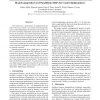Free Online Productivity Tools
i2Speak
i2Symbol
i2OCR
iTex2Img
iWeb2Print
iWeb2Shot
i2Type
iPdf2Split
iPdf2Merge
i2Bopomofo
i2Arabic
i2Style
i2Image
i2PDF
iLatex2Rtf
Sci2ools
HPCA
2008
IEEE
2008
IEEE
Branch-mispredict level parallelism (BLP) for control independence
A microprocessor's performance is fundamentally limited by the rate at which it can resolve branch mispredictions. Control independence (CI) architectures look for useful control and data independent instructions to fetch and execute in the shadow of a branch misprediction. This paper demonstrates that CI architectures can be guided to exploit substantial branch-mispredict level parallelism (BLP) in existing control intensive applications. A program has branch-mispredict level parallelism when its dynamic execution trace contains hard-to-predict branches that are both control and data independent, and thus could, potentially, be resolved in parallel. Although applications have a high degree of inherent BLP, we find that the amount of BLP exploited by naive CI architectures tends to be quite small. We show that spawn selection and data dependence handling policies in a CI architecture should make choices that explicitly aim to maximize branch-mispredict level parallelism. We demon...
Branch-mispredict Level Parallelism | Computer Architecture | HPCA 2008 | Inherent Blp | Naive Ci Architectures |
| Added | 01 Dec 2009 |
| Updated | 01 Dec 2009 |
| Type | Conference |
| Year | 2008 |
| Where | HPCA |
| Authors | Kshitiz Malik, Mayank Agarwal, Sam S. Stone, Kevin M. Woley, Matthew I. Frank |
Comments (0)

